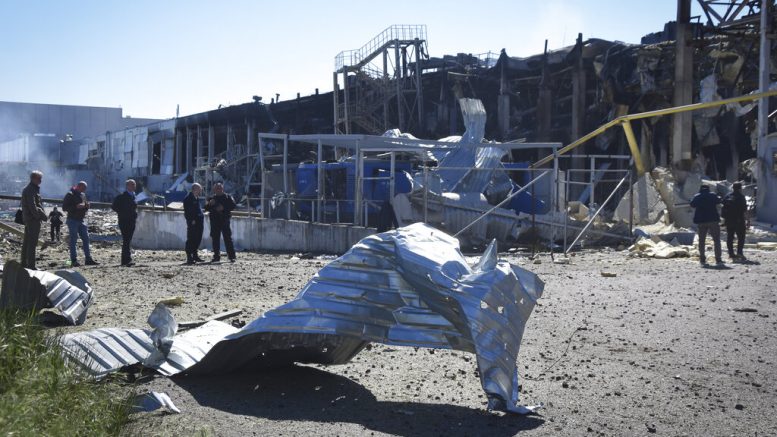ZAPORIZHZHIA, Ukraine (AP) — Russian troops pounded away at the vital port of Odesa, Ukrainian officials said Tuesday, apparently as part of efforts to disrupt the supply lines and weapons shipments that have been critical to Kyiv’s defense.
Ukraine’s ability to stymie a larger, better-armed Russian military has surprised many observers, who had anticipated a much quicker conflict. With the war now in its 11th week and Kyiv bogging Russian forces down in many places and even staging a counteroffensive in others, Ukraine’s foreign minister appeared to suggest that the country could expand its aims beyond merely pushing Russia back to areas it or its allies held on the day of Feb. 24 invasion.
One of the most dramatic examples of Ukraine’s ability to deny Russia easy victories has been Mariupol, where Ukrainian fighters remain holed up at a steel plant despite a monthslong siege. The regiment defending the plant said Tuesday that Russian warplanes continued pounding it.
In recent days, the United Nations and Red Cross organized a dramatic rescue of what some officials said were the last civilians trapped at the plant. But on Tuesday, two officials said about 100 were believed to still be in the complex’s underground tunnels. Others said that was impossible to confirm.
In another harrowing example of the grisly toll the war continues to take, the Ukrainians said they found the bodies of 44 civilians in the rubble of a building in the northeast that was destroyed weeks ago.
The Ukrainian military said Tuesday that Russian forces fired seven missiles a day earlier from the air at Ukraine’s largest port, Odesa, hitting a shopping center and a warehouse. One person was killed and five were wounded, the military said.
Images overnight showed a burning building and detritus — including an abandoned tennis shoe — in a heap of destruction in the city on the Black Sea. At daybreak, Mayor Gennady Trukhanov visited the warehouse and said it “had nothing in common with military infrastructure or military objects.”
Ukraine alleged at least some of the munitions used dated back to the Soviet era, making them unreliable in targeting. But the Center for Defense Strategies, a Ukrainian think tank tracking the war, said Moscow used some precision weapons against Odesa: Kinzhal, or “Dagger,” hypersonic air-to-surface missiles.
Ukrainian, British and American officials warn Russia is rapidly using up its stock of precision weapons and may not be able to quickly build more, raising the risk of more imprecise rockets being used as the conflict grinds on.
Ever since President Vladimir Putin’s forces failed to take Kyiv in the early days of the war, he has said his focus is the country’s eastern industrial heartland of the Donbas — but one general has suggested Moscow’s aims also include cutting Ukraine off from its entire Black Sea coast in the south.
That would also give it a swath of territory that would link Russia to both the Crimean Peninsula, which it seized in 2014, and Transnistria, a pro-Russian breakaway region of Moldova.
Even if it falls short of severing Ukraine from the Black Sea — and it appears to lack the forces to do so — continuing missile strikes on Odesa reflect the city’s importance as a strategic transport hub. The Russian military has repeatedly targeted the city’s airport and claimed that it has destroyed several batches of Western weapons.
Odesa is also a major gateway for grain shipments, and Russia’s blockade of it is already threatening global food supplies. Beyond that, the city is a cultural jewel, dear to Ukrainians and Russians alike, and targeting it carries symbolic significance as well.
In Mariupol, Russians also bombarded the Azovstal steel mill, the Azov regiment said, targeting the sprawling complex 34 times over the past 24 hours. Attempts to storm the plant also continued.
Meanwhile, Petro Andryushchenko, an advisor to the city’s mayor, estimated in a social media post that at least 100 civilians remain trapped the plant complex. Donetsk regional governor Pavlo Kyrylenko said that those civilians remaining were people “that the Russians have not selected” for evacuation.
The two officials didn’t say how they knew that there were still civilians in the complex — a warren of tunnels and bunkers spread over 11 square kilometers (4 square miles). Sviatoslav Palamar, the deputy commander of the Azov regiment, told The Associated Press that he could not confirm any civilians remained. Mayor Vadym Boichenko also said there was no way to know.
With Russian forces struggling to gain ground in the Donbas, military analysts suggest that hitting Odesa might serve to stoke concern about southwestern Ukraine, thus forcing Kyiv to station more forces there. That would pull them away from the eastern front as its military stages counteroffensives near the city of Kharkiv, aiming to push the Russians back across the border there.
Kharkiv and the surrounding area have been under sustained Russian attack since the beginning of the war in late February. In recent weeks, grisly pictures testified to the horrors of those battles, with charred and mangled bodies strewn in one street.
Dozens of bodies were found in a five-story building that collapsed in March in Izyum, about 120 kilometers (75 miles) from Kharkiv, Oleh Synehubov, the head of the regional administration, said Tuesday in a social media message.
Ukraine’s foreign minister, meanwhile, appeared to voice increasing confidence — and expanded goals — amid the stalled Russian offensive.
“In the first months of the war the victory for us looked like withdrawal of Russian forces to the positions they occupied before Feb. 24 and payment for inflicted damage,” Dmytro Kuleba said in an interview with the Financial Times newspaper. “Now if we are strong enough on the military front and we win the battle for Donbas, which will be crucial for the following dynamics of the war, of course the victory for us in this war will be the liberation of the rest of our territories.”
That appears to indicate that Ukraine wants to try to retake Crimea and regions of the Donbas taken by Russia and the separatists it backs.
But the comments seemed to reflect political ambitions more than battlefield realities: Many analysts acknowledge that while Russia isn’t capable of making quick gains, the Ukrainian military isn’t strong enough to drive the Russians back.
U.S. estimates suggest Russia still has some 97 battalion tactical groups in Ukraine itself — as many as 97,000 troops — and more across the border.
Also Tuesday, the Ukrainian military warned that Russia could target the country’s chemical industries. The claim wasn’t immediately explained in the report. But Russian shelling has previously targeted oil depots and other industrial sites during the war.
In Washington, President Joe Biden signed a bipartisan measure to reboot the World War II-era “lend-lease” program, which helped defeat Nazi Germany, to bolster Kyiv and Eastern European allies.
Elsewhere on the diplomatic front, Western powers continued to rally around Kyiv’s embattled government. German Foreign Minister Annalena Baerbock traveled to the Kyiv suburb of Bucha, where the bodies of civilians — some bound, burned, or shot at close range — were found after Russian forces withdrew.
“We owe it to the victims that we don’t just commemorate them here but that we hold the perpetrators to account,” she said.






























